Sarees have been a part of Indian culture for centuries, representing a blend of tradition, region, and textile artistry. From rich Banarasi weaves to breezy cotton Tant sarees, the Indian saree scene is a kaleidoscope of vibrant varieties. In this article, we explore the most popular, traditional, and modern types of sarees names, their origins, styling ideas, and unique features.
According to Wikipedia, the saree (or sari) dates back to the Indus Valley Civilisation, making it one of the world’s oldest forms of attire still in fashion. Whether you’re a bride-to-be, fashion enthusiast, or someone exploring Indian culture, this detailed guide is for you.
Table of Contents
🇮🇳 Why Understanding the Types of Sarees Names Matters
The types of sarees names reveal not just fashion choices but also stories, craftsmanship, and centuries-old traditions. From grand weddings to spiritual ceremonies and everyday elegance, each saree type has a cultural significance that enhances its beauty.
🌟 Popular Types of Sarees Names in India
India is home to over 30+ unique types of sarees, each woven in a particular region with its own set of traditions and techniques. Below are some of the most famous ones loved across generations.
1. Banarasi Saree – Regal and Luxurious
Origin: Varanasi, Uttar Pradesh
Fabric: Silk with zari work
Banarasi sarees are one of the most exquisite saree varieties in India. Known for their rich silk fabric and heavy gold and silver zari work, these sarees often feature Mughal-inspired designs like floral motifs, jhallar borders, and intricate patterns.
Styling Tip: Best paired with heavy gold jewelry and a matching blouse for weddings.
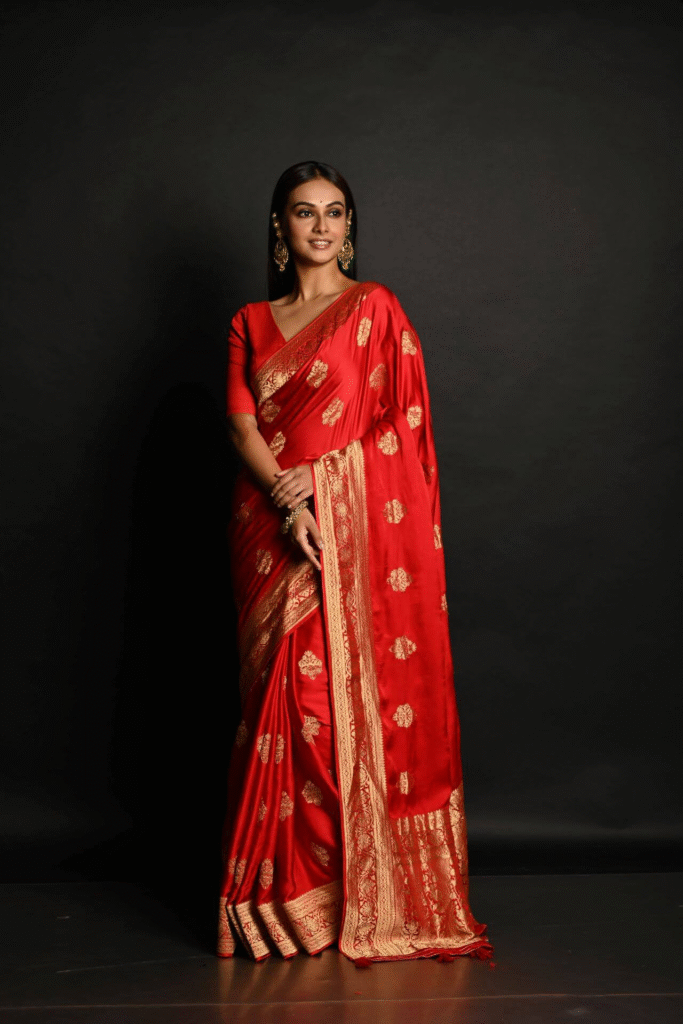
2. Kanjeevaram Saree – South India’s Silk Treasure
Origin: Kanchipuram, Tamil Nadu
Fabric: Pure mulberry silk
The Kanjeevaram saree is among the most luxurious and traditional sarees names in the South. Recognized by its vivid hues, temple borders, and mythological motifs, it’s a bridal favorite.
Styling Tip: Pair with contrast blouses and temple jewelry for a classic South Indian look.

3. Chanderi Saree – Elegant and Lightweight
Origin: Madhya Pradesh
Fabric: Silk, cotton, or a blend
This saree type is ideal for formal and casual occasions. Chanderi sarees are celebrated for their lightweight texture, sheen, and luxurious feel.
Styling Tip: Drape with minimalist silver jewelry and pastel-toned blouses.
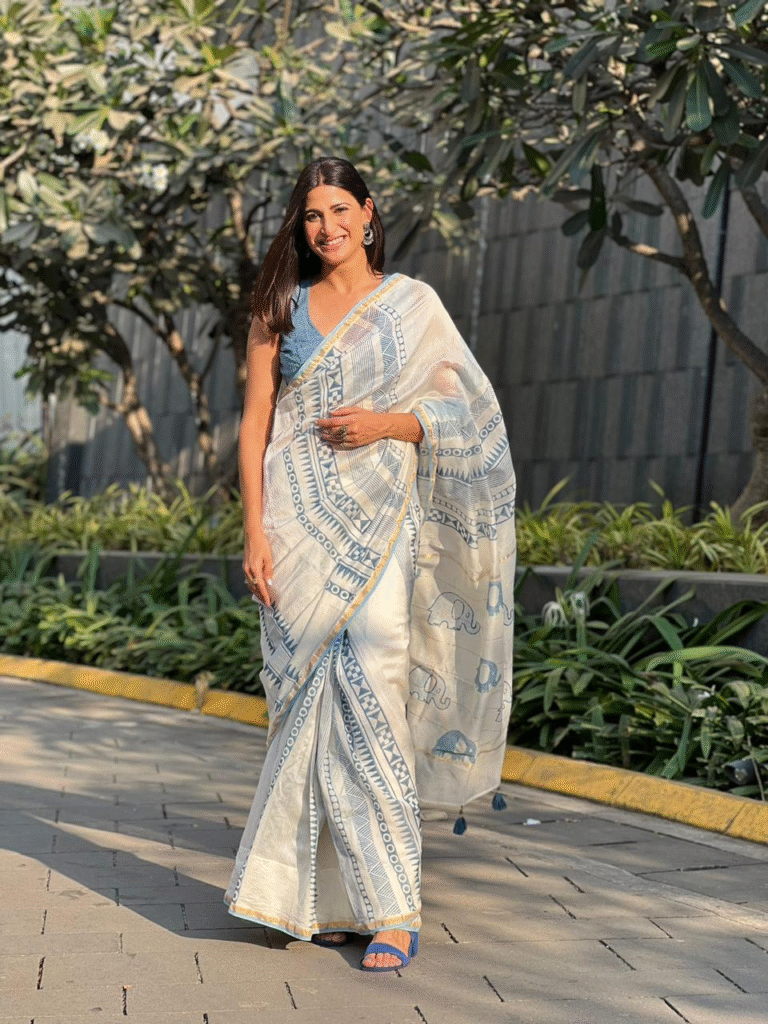
4. Tant Saree – Bengal’s Handloom Gem
Origin: West Bengal
Fabric: Starched cotton
Perfect for daily and summer wear, Tant sarees are known for their crisp texture, beautiful thread work, and wide contrasting borders.
Styling Tip: Go for a bindi, casual jhumkas, and open hair for a traditional Bengali look.
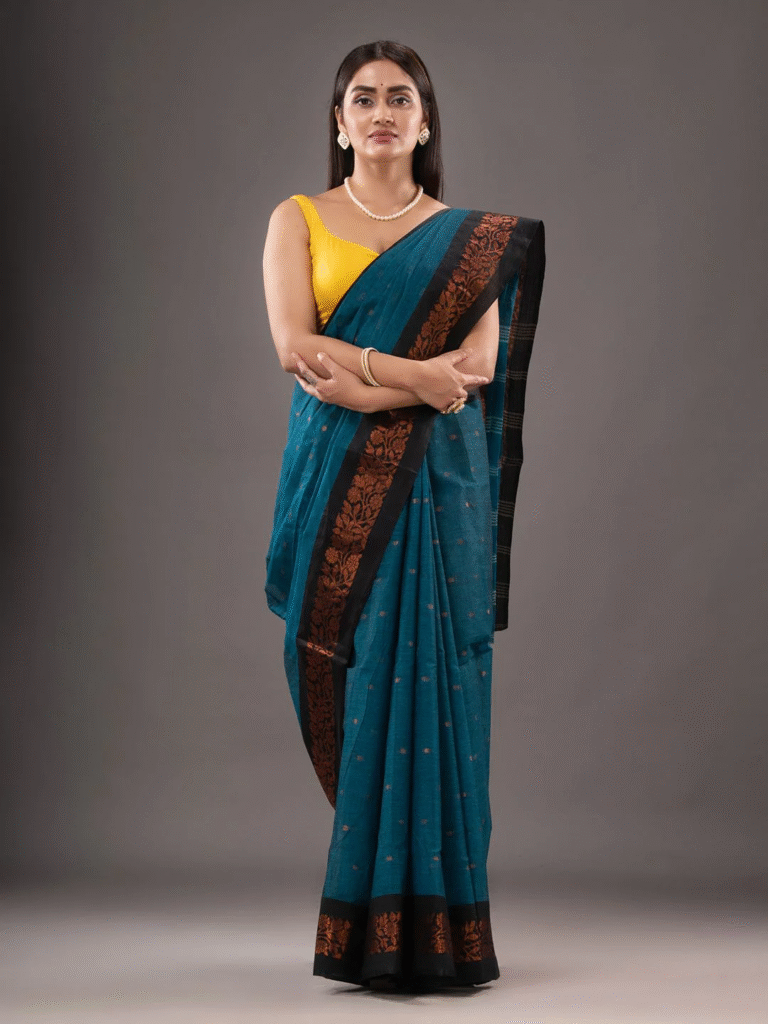
5. Bandhani Saree – Dots of Culture
Origin: Gujarat and Rajasthan
Fabric: Cotton, silk, or georgette
Bandhani sarees are made using a unique tie-dye technique, resulting in colorful dotted patterns and traditional designs. Ideal for festivals like Navratri.
Styling Tip: Choose mirror-work blouses and ethnic bangles to complement the vibrant prints.

6. Paithani Saree – Maharashtrian Elegance
Origin: Maharashtra
Fabric: Silk with zari pallu
Recognized by its peacock motifs and contrasting pallu, Paithani sarees are treasured heirlooms in Maharashtrian households.
Styling Tip: Wear with a nose ring (nath), chandrakor bindi, and green bangles for an authentic look.
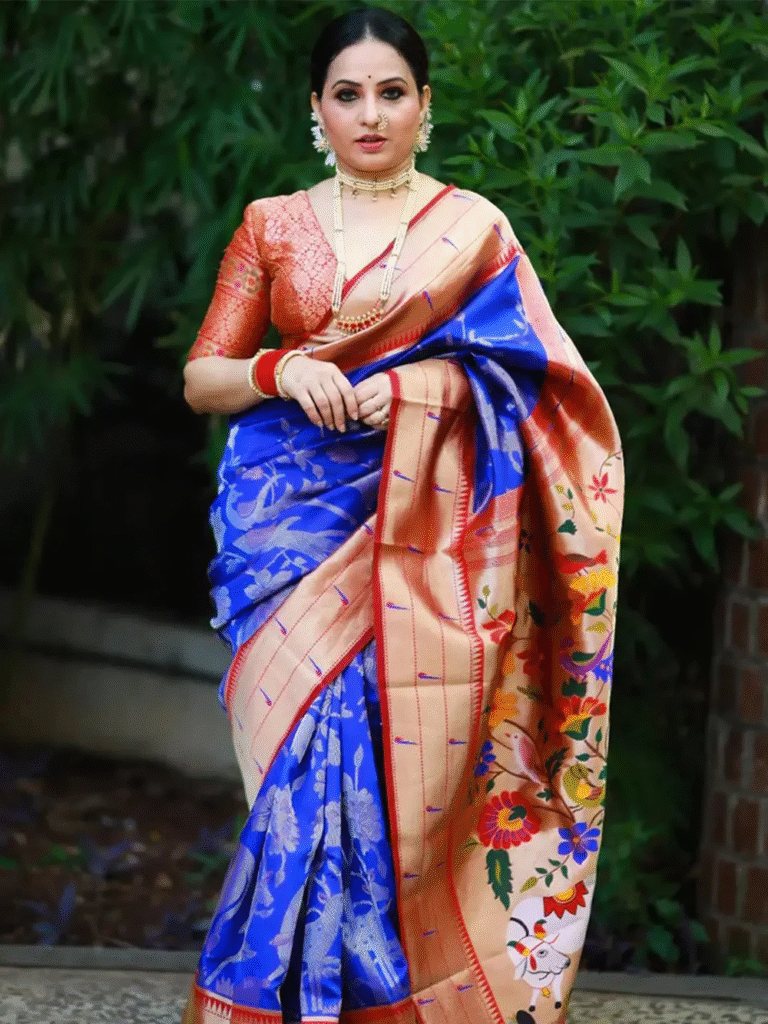
🧵 Traditional Saree Names Based on Region
India’s traditional sarees names change dramatically from state to state. Here’s a list that highlights different types of sarees and their regional significance.
7. Sambalpuri Saree – Odisha’s Ikat Pride
Known for its geometric patterns and contrasting pallus, Sambalpuri sarees are created using the Ikat dyeing technique where yarns are dyed before weaving.

8. Pochampally Saree – Telangana’s Ikat Innovation
Similar to Sambalpuri but more symmetrical in design, Pochampally sarees are woven in bright hues and abstract patterns.

9. Kota Doria Saree – Rajasthan’s Light Wonder
A blend of cotton and silk, Kota sarees are light and airy, ideal for hot summers. They feature tiny square patterns known as khats.
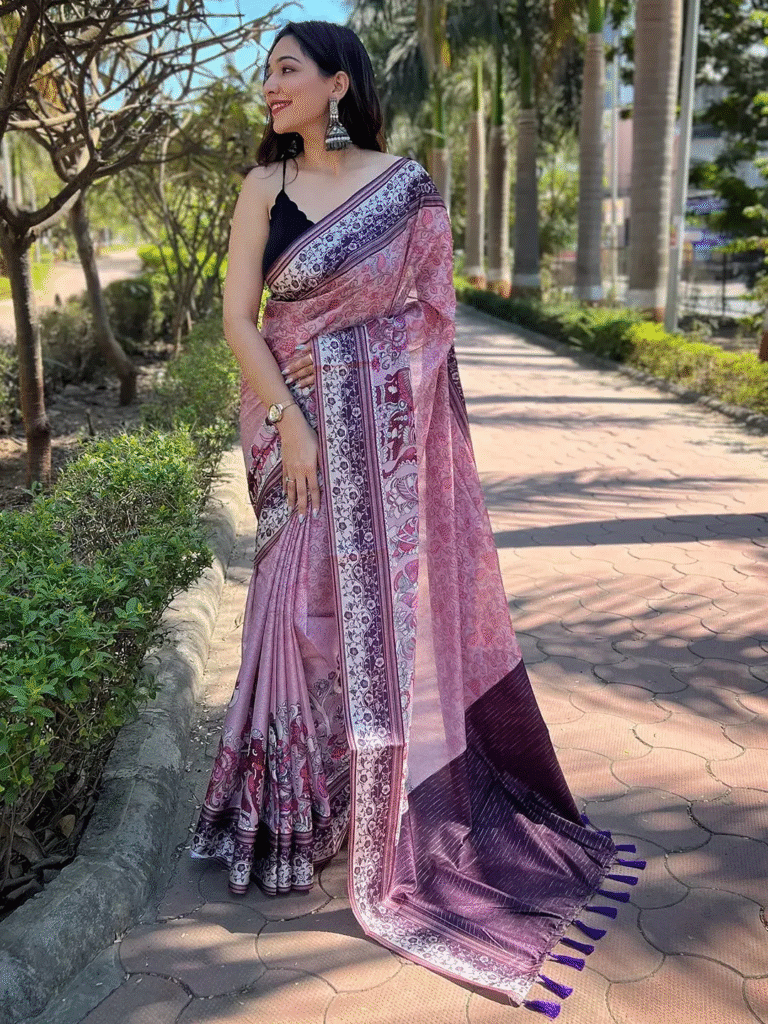
10. Muga Silk Saree – Assam’s Golden Silk
Made from rare Muga silk, these sarees glow naturally and last for decades. A true pride of Assam.

✨ Latest Saree Types for Modern Fashionistas
Modern Indian designers are constantly blending traditional elements with contemporary styles. Here are some new saree types that appeal to younger generations.
11. Ruffle Saree – Chic and Contemporary
With cascading frills and lightweight fabrics, ruffle sarees are a hit at parties and sangeets.
12. Pant Style Saree – Fusion and Functional
Pre-stitched trousers replace the traditional petticoat, making this saree variety ideal for comfort without compromising style.
13. Gown Saree – One-Piece Draped Magic
These sarees combine the grace of a saree with the silhouette of a gown. Ideal for cocktail nights and receptions.
14. Half and Half Saree – Two Fabrics, One Look
This type of saree features contrasting fabrics or prints on the pleats and pallu, creating a dual-toned effect.
15. Dhoti Style Saree – Boho Vibes
Inspired by the dhoti drape, this look blends ethnic and urban styles for a bold, festive appearance.
🧶 Other Famous Types of Sarees Names in India
| Saree Type | Origin | Fabric | Key Features |
|---|---|---|---|
| Kasavu Saree | Kerala | Cotton/Silk | White with golden border |
| Mangalagiri | Andhra Pradesh | Cotton | Nizam border, simple weaves |
| Bhagalpuri | Bihar | Tussar Silk | Earthy colors, natural sheen |
| Gota Patti | Rajasthan | Georgette | Heavy Gota embroidery |
| Chikankari | Lucknow | Cotton/Georgette | Intricate hand embroidery |
📸 Visual Styling Tips by Saree Types
- Traditional Types of Sarees: Pair with heritage jewelry, jasmine flowers, and embroidered clutches.
- Modern Saree Styles: Add a belt, crop top blouse, or sneakers for a fusion twist.
- Cotton Sarees: Opt for oxidized accessories and jute handbags for an everyday ethnic vibe.
❓ FAQs on Types of Sarees Names
What are the most famous types of sarees in India?
The most popular saree types include Banarasi, Kanjeevaram, Chanderi, Paithani, and Bandhani.
Which types of sarees are best for summer?
Tant, Kota Doria, and Chikankari cotton sarees are breathable and ideal for hot climates.
What are the latest trending saree styles?
Ruffle sarees, pant-style sarees, and gown sarees are trending among millennials and Gen Z.
How do I know which saree suits me?
Base it on your body type, occasion, and comfort. For instance, petite frames look great in chiffon while curvier figures shine in silk.
Are there saree types for office wear?
Yes, formal cotton sarees like Mangalagiri, Chanderi, and Bengal Tant are great for the office.
Can I wear a saree casually?
Absolutely! Casual sarees like cotton and linen sarees are perfect for daily and semi-formal outings.
Which saree types are easy to drape?
Georgette, crepe, and pre-stitched sarees are easier to drape than traditional handloom types.
Where can I buy different types of sarees online?
Platforms like Suta, FabIndia, and Jaypore offer a wide range of authentic sarees.
🧵 Final Thoughts: Embracing the Saree’s Timeless Charm
From types of sarees names that reflect ancient heritage to modern, edgy drapes for today’s woman, the saree continues to evolve while holding onto its cultural roots. Each weave and stitch tells a story of artisans, traditions, and timeless grace. Whether you’re attending a wedding, working in an office, or enjoying a casual brunch, there’s a saree type waiting to wrap you in its elegance.
👉 Don’t miss our guide on Types of Blouse Designs to complete your saree look with matching flair.
